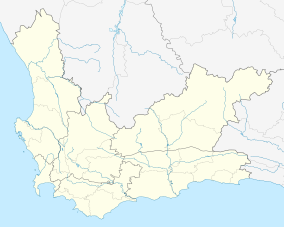Protected area in Western Cape, South Africa
The Cape Winelands Biosphere Reserve is located in the Western Cape Province of South Africa approximately 40 km (25 mi) east of Cape Town. The Biosphere Reserve extends from the Kogelberg Biosphere Reserve in the south, northwards along the Cape Fold Belt Mountain Chain and the adjoining valleys constituting the Cape Winelands. The Biosphere Reserve incorporates key portions of the registered Cape Floral Region Protected Areas World Heritage Site. The Reserve was designated in 2007.
General description
The Biosphere Reserve is characterised by a mosaic of diverse ecosystems and physiographic environments, and a gradation of land-uses and human settlement patterns associated with the world-renowned Cape Winelands viticultural landscape. The area includes an array of historic towns, hamlets and farmsteads, which are home to approximately 320 024 people.
Main economic activities in the area include agriculture, manufacturing, tourism, forestry, real estate, and business services. Agriculture forms the backbone of the economy with most of the other sectors being dependent on its strong backward and forward linkages.
The key management focal areas of the Biosphere Reserve include:
- coordination of conservation activities with the focus on protection of the Cape Floral Region Protected Areas World Heritage Site and its associated ecosystems;
- provision of a sustained flow of high-quality water to adjoining regions (including the Cape West Coast) and the City of Cape Town; and
- promotion of sustainable development in order to alleviate poverty and inequality.
Major ecosystem type
Cape Floral Kingdom incorporating Mountain Fynbos and Renosterveld.
Major habitats & land cover types
- Endangered vegetation types, including Mountain and Sand Plain
- Fynbos; various types of Renosterveld (e.g. Central Mountain Renosterveld, South and South-West Coast Renosterveld), and Little Succulent Karoo.
- Diversity of topographic features including a key portion of the Cape Fold Mountains, valleys and open plains, and a unique cultural landscape characterised by vineyards, pastures, wheat fields, commercial plantations, and a built environment characterised by the distinctive Cape Dutch architectural vernacular.
Location : 33° 18’ 0.19” to 34° 9’ 2.12” South; 18° 42’ 29.93” to 19° 29’ 5.99” East
Area (hectares) : 322,030
Core area(s) : 99,459
Buffer zone(s) : 133,844
Transition area(s) when given : 88,727
Altitude (metres above sea level) : 20 m to 1 860 m.
Administrative authorities
The administrative authority is Cape Winelands District Municipality, in association with:
Sources
 This article incorporates text from a free content work. (license statement/permission). Text taken from UNESCO - MAB Biosphere Reserves Directory, UNESCO, UNESCO.
This article incorporates text from a free content work. (license statement/permission). Text taken from UNESCO - MAB Biosphere Reserves Directory, UNESCO, UNESCO.

